
Unit 3 FRQ (Circular Motion & Gravitation) Answers
3 min read•november 29, 2021
AP Physics 1 Free Response Question Answers for Circular Motion & Gravitation
👋 Welcome to the AP Physics Unit 3 FRQ ( & ) Answers. Have your responses handy as you go through the rubrics to see how you did!
⏱ Remember, the AP Physics 1 exam has 5 free-response questions, and you will be given 90 minutes to complete the FRQ section. (This means you should give yourself ~18 minutes to go through each practice FRQ.)
Setup
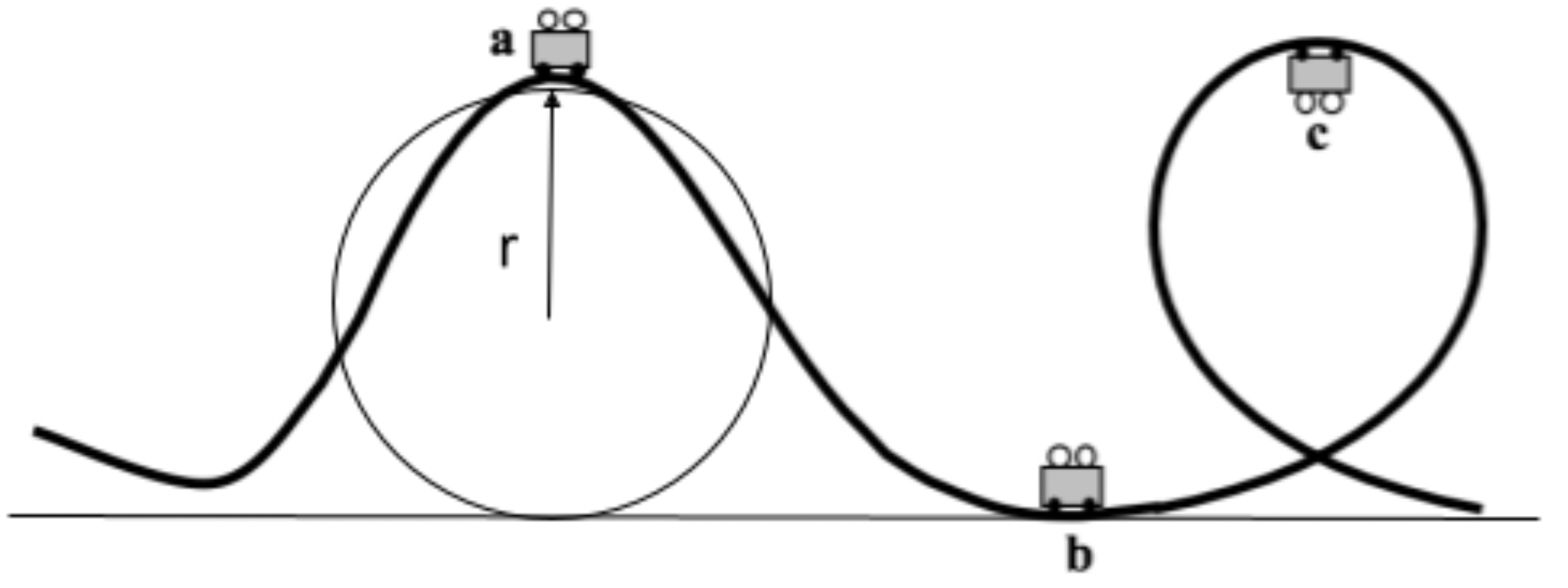
A portion of a rollercoaster is shown above. At point a, the track has a radius of approximately 3.0 m and the cart has a speed of 2.2 m/s. The mass of the rider is approximately 60 kg. We will be ignoring the mass of the car.
Questions with Answers & Rubric
Part A
(i) Without manipulating equations, state whether the rider feels lighter, heavier, or the same as they normally would while standing still on earth. Briefly explain your reasoning. (2pts)
1pt: The rider feels lighter.
1pt: The of the rider is smaller than the force due to gravity, since the rider is going over the hill and the net force is directed in the direction of the center of the circle (down, in this case).
📄 Additional Resources
Study Guide: Applications of Newton’s Second Law
(ii) On the dot below, draw and label a free body diagram for the rider at point a. (2pts)
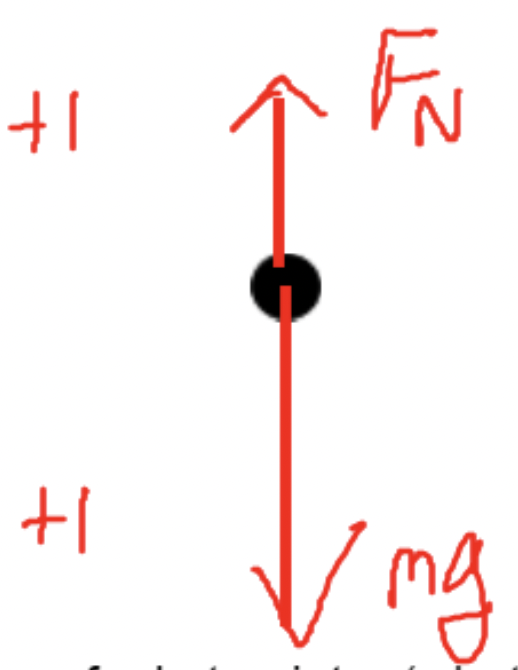
📄 Additional Resources
(iii) How heavy would a 60 kg passenger feel at point a? (What is their apparent weight?) Make sure you show ALL work! (3pts)
1pt: Fn = 503.2 N

📄 Additional Resources
Study Guide: Applications of Newton's Second Law
Part B
At point b, the track has a radius of 13m and the rider feels four times heavier than normal.
(i) Without manipulating equations, state whether the rider is moving faster, slower, or the same speed at point b as they were at point a. Briefly explain your reasoning. (2pts)
1pt: The rider is moving faster.
1pt: The rider has potential energy due to gravity at point a, which is then converted to kinetic energy at point b, and therefore must have more speed at b.
📄 Additional Resources
(ii) On the dot below, draw a free body diagram for the rider. (2pts)
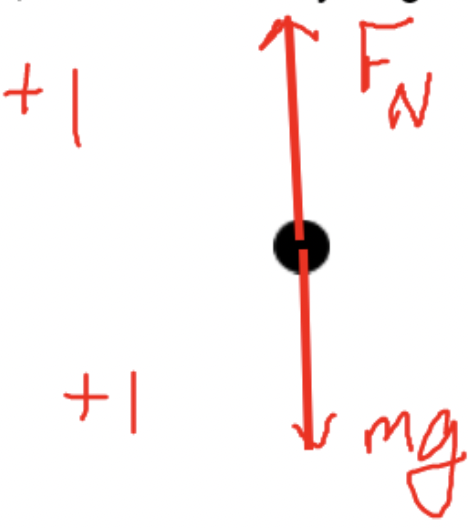
📄 Additional Resources
(iii) How fast is the rider traveling at point b? Make sure to show all your work. (4pts)
1pt: V = 19.7 m/s
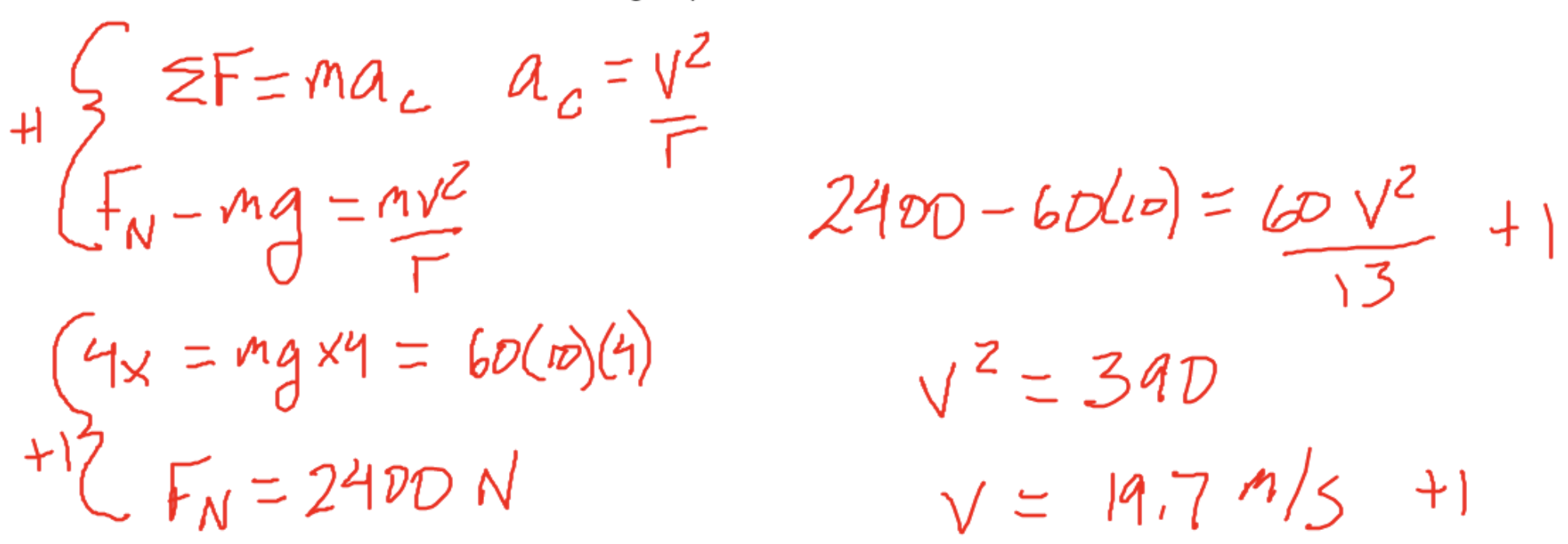
📄 Additional Resources
Study Guide: Centripetal Acceleration and Centripetal Force
Part C
At point c, the track and cart exert a force of 400 N on the 60 kg rider. Their velocity is 7.0 m/s.
(i) On the dot below, draw a free-body diagram for the rider at point c. (2pts)
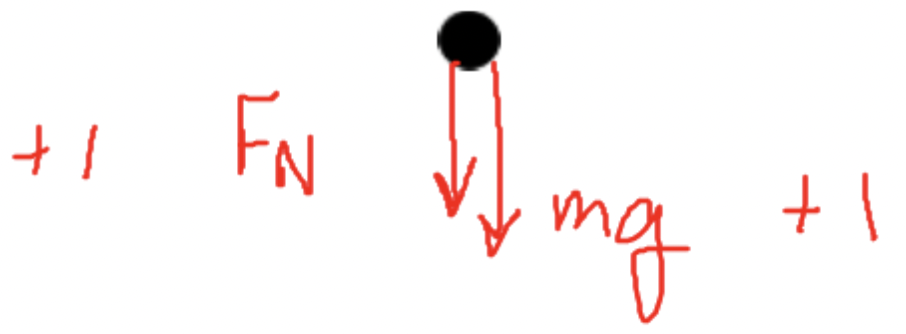
(ii) Determine the radius of the track at point c. Make sure to show all work. (2pts)
1pt: r = 2.94m
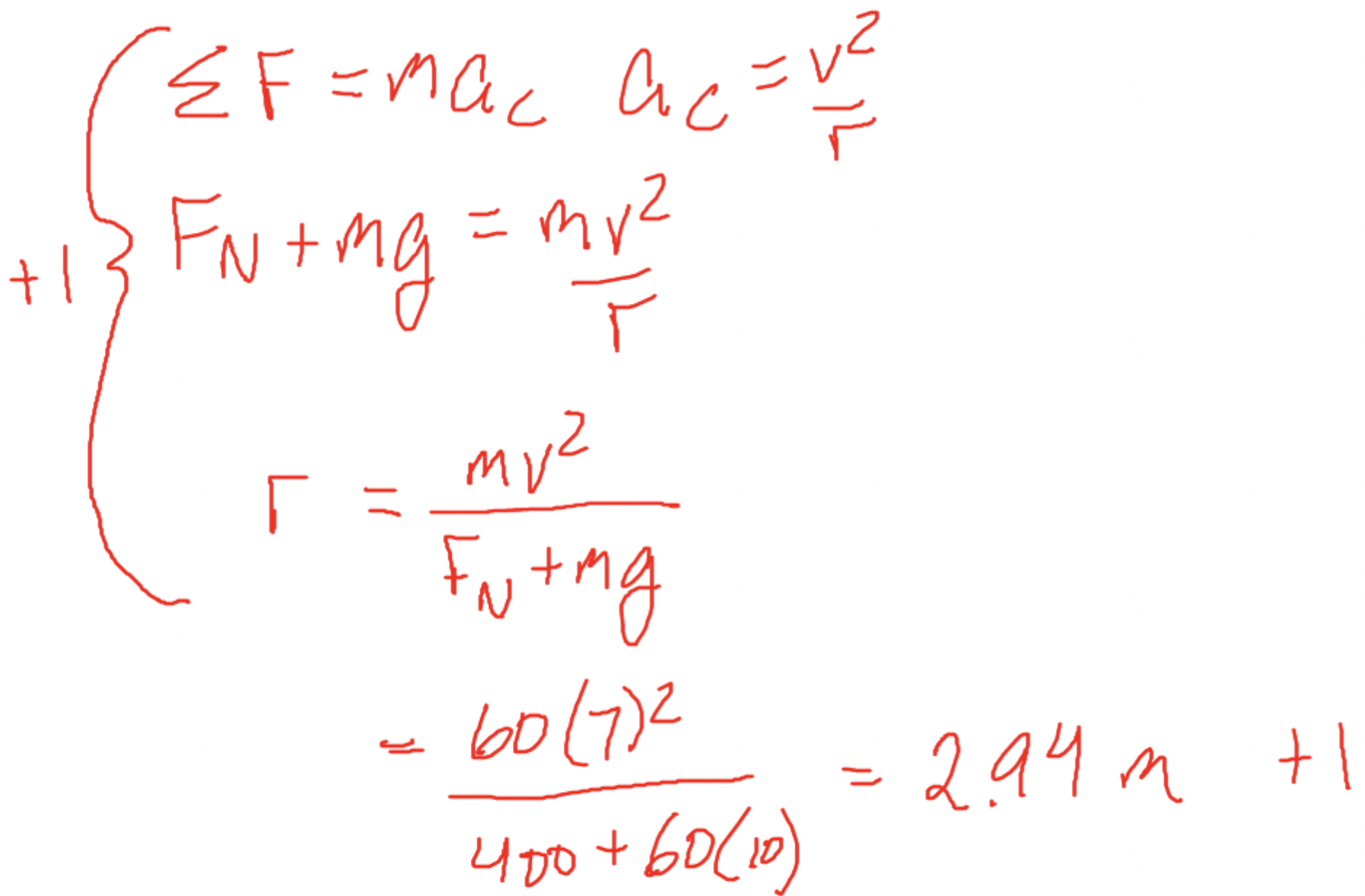
Next Steps
🧠 Want to continue reinforcing your knowledge of Unit 3? Check out Unit 3 Trivia, either as a document or as a game.
⏭ Ready to move on to the next topic? Take a look at the collection of Unit 4 Resources.
📚 Want to review multiple units? Check out all of the AP Physics 1 FRQs.
🤝 Got more questions? Want to help others studying the same topic? Jump into a room in Hours!
Key Terms to Review (10)
Apparent Weight
: Apparent weight refers to what we perceive as our weight when we are in non-inertial reference frames, such as when accelerating or decelerating. It can differ from our actual weight due to additional forces acting on us.Centripetal Acceleration
: Centripetal acceleration is the acceleration experienced by an object moving in a circular path. It is always directed towards the center of the circle and its magnitude can be calculated using the formula a = v^2/r, where v is the velocity of the object and r is the radius of the circle.Circular Motion
: Circular motion refers to the movement of an object in a circular path around a central point. It involves constant change in direction but not necessarily speed.Conservation of Energy
: The principle that states that energy cannot be created or destroyed but can only be transferred or transformed from one form to another.Free-body Diagrams
: Free-body diagrams are visual representations used to analyze forces acting on an isolated system or individual objects within that system. They help identify and understand all external forces acting upon an object.Gravitation
: Gravitation is the force of attraction between two objects with mass. It is responsible for keeping planets in orbit around the sun and objects on Earth's surface.Newton’s Second Law
: Newton’s Second Law states that when an external force acts on an object, it causes acceleration in the direction of that force. The magnitude of this acceleration depends on both the net force applied and the mass of the object.Normal Force
: The normal force is the force exerted by a surface to support the weight of an object resting on it. It acts perpendicular to the surface.Uniform Circular Motion
: Uniform circular motion refers to an object moving along a circular path with constant speed. The object experiences acceleration towards the center of the circle, known as centripetal acceleration.Work-Energy Principle
: The work-energy principle states that the work done on an object equals its change in kinetic energy. It relates the concept of work, which is the transfer of energy through force, to changes in an object's motion and energy.Unit 3 FRQ (Circular Motion & Gravitation) Answers
3 min read•november 29, 2021
AP Physics 1 Free Response Question Answers for Circular Motion & Gravitation
👋 Welcome to the AP Physics Unit 3 FRQ ( & ) Answers. Have your responses handy as you go through the rubrics to see how you did!
⏱ Remember, the AP Physics 1 exam has 5 free-response questions, and you will be given 90 minutes to complete the FRQ section. (This means you should give yourself ~18 minutes to go through each practice FRQ.)
Setup

A portion of a rollercoaster is shown above. At point a, the track has a radius of approximately 3.0 m and the cart has a speed of 2.2 m/s. The mass of the rider is approximately 60 kg. We will be ignoring the mass of the car.
Questions with Answers & Rubric
Part A
(i) Without manipulating equations, state whether the rider feels lighter, heavier, or the same as they normally would while standing still on earth. Briefly explain your reasoning. (2pts)
1pt: The rider feels lighter.
1pt: The of the rider is smaller than the force due to gravity, since the rider is going over the hill and the net force is directed in the direction of the center of the circle (down, in this case).
📄 Additional Resources
Study Guide: Applications of Newton’s Second Law
(ii) On the dot below, draw and label a free body diagram for the rider at point a. (2pts)

📄 Additional Resources
(iii) How heavy would a 60 kg passenger feel at point a? (What is their apparent weight?) Make sure you show ALL work! (3pts)
1pt: Fn = 503.2 N

📄 Additional Resources
Study Guide: Applications of Newton's Second Law
Part B
At point b, the track has a radius of 13m and the rider feels four times heavier than normal.
(i) Without manipulating equations, state whether the rider is moving faster, slower, or the same speed at point b as they were at point a. Briefly explain your reasoning. (2pts)
1pt: The rider is moving faster.
1pt: The rider has potential energy due to gravity at point a, which is then converted to kinetic energy at point b, and therefore must have more speed at b.
📄 Additional Resources
(ii) On the dot below, draw a free body diagram for the rider. (2pts)

📄 Additional Resources
(iii) How fast is the rider traveling at point b? Make sure to show all your work. (4pts)
1pt: V = 19.7 m/s

📄 Additional Resources
Study Guide: Centripetal Acceleration and Centripetal Force
Part C
At point c, the track and cart exert a force of 400 N on the 60 kg rider. Their velocity is 7.0 m/s.
(i) On the dot below, draw a free-body diagram for the rider at point c. (2pts)

(ii) Determine the radius of the track at point c. Make sure to show all work. (2pts)
1pt: r = 2.94m

Next Steps
🧠 Want to continue reinforcing your knowledge of Unit 3? Check out Unit 3 Trivia, either as a document or as a game.
⏭ Ready to move on to the next topic? Take a look at the collection of Unit 4 Resources.
📚 Want to review multiple units? Check out all of the AP Physics 1 FRQs.
🤝 Got more questions? Want to help others studying the same topic? Jump into a room in Hours!
Key Terms to Review (10)
Apparent Weight
: Apparent weight refers to what we perceive as our weight when we are in non-inertial reference frames, such as when accelerating or decelerating. It can differ from our actual weight due to additional forces acting on us.Centripetal Acceleration
: Centripetal acceleration is the acceleration experienced by an object moving in a circular path. It is always directed towards the center of the circle and its magnitude can be calculated using the formula a = v^2/r, where v is the velocity of the object and r is the radius of the circle.Circular Motion
: Circular motion refers to the movement of an object in a circular path around a central point. It involves constant change in direction but not necessarily speed.Conservation of Energy
: The principle that states that energy cannot be created or destroyed but can only be transferred or transformed from one form to another.Free-body Diagrams
: Free-body diagrams are visual representations used to analyze forces acting on an isolated system or individual objects within that system. They help identify and understand all external forces acting upon an object.Gravitation
: Gravitation is the force of attraction between two objects with mass. It is responsible for keeping planets in orbit around the sun and objects on Earth's surface.Newton’s Second Law
: Newton’s Second Law states that when an external force acts on an object, it causes acceleration in the direction of that force. The magnitude of this acceleration depends on both the net force applied and the mass of the object.Normal Force
: The normal force is the force exerted by a surface to support the weight of an object resting on it. It acts perpendicular to the surface.Uniform Circular Motion
: Uniform circular motion refers to an object moving along a circular path with constant speed. The object experiences acceleration towards the center of the circle, known as centripetal acceleration.Work-Energy Principle
: The work-energy principle states that the work done on an object equals its change in kinetic energy. It relates the concept of work, which is the transfer of energy through force, to changes in an object's motion and energy.
Resources
© 2024 Fiveable Inc. All rights reserved.
AP® and SAT® are trademarks registered by the College Board, which is not affiliated with, and does not endorse this website.